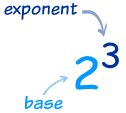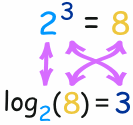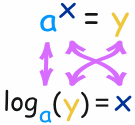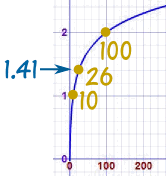Introduction
In its simplest form, a logarithm answers the question:
How many of one number do we multiply to get another number?
Example:
How many 2s do we multiply to get 8?
Answer: 2 × 2 × 2 = 8, so we needed to multiply 3 of the 2s to get 8
So the logarithm is 3
How to Write it
We write "the number of 2s we need to multiply to get 8 is 3" as:
log2(8) = 3
So these two things are the same:
 |
The number we are multiplying is called the "base", so we can say:
- "the logarithm of 8 with base 2 is 3"
- or "log base 2 of 8 is 3"
- or "the base-2 log of 8 is 3"
Notice we are dealing with three numbers:
- the base: the number we are multiplying (a "2" in the example above)
- how many times to use it in a multiplication (3 times, which is the logarithm)
- The number we want to get (an "8")
More Examples
Exponents
Exponents and Logarithms are related, let's find out how ...
 |
The exponent says how many times to use the number in a multiplication.
In this example: 23 = 2 × 2 × 2 = 8
(2 is used 3 times in a multiplication to get 8)
|
So a logarithm answers a question like this:

In this way:

The logarithm tells us what the exponent is!
In that example the "base" is 2 and the "exponent" is 3:

So the logarithm answers the question:
What exponent do we need
(for one number to become another number) ?
(for one number to become another number) ?
The general case is:

Common Logarithms: Base 10
Sometimes a logarithm is written without a base, like this:
log(100)
This usually means that the base is really 10.

It is called a "common logarithm". Engineers love to use it.
On a calculator it is the "log" button.
It is how many times we need to use 10 in a multiplication, to get our desired number.
Example: log(1000) = log10(1000) = 3
Logarithms Can Have Decimals
All of our examples have used whole number logarithms (like 2 or 3), but logarithms can have decimal values like 2.5, or 6.081, etc.
Negative Logarithms
| − | Negative? But logarithms deal with multiplying. What could be the opposite of multiplying? Dividing! |
A negative logarithm means how many times to divide by the number.
We could have just one divide:
Or many divides:
It All Makes Sense
Multiplying and Dividing are all part of the same simple pattern.
Let us look at some Base-10 logarithms as an example:
| Number | How Many 10s | Base-10 Logarithm | ||
|---|---|---|---|---|
 | .. etc.. | |||
| 1000 | 1 × 10 × 10 × 10 | log10(1000) | = 3 | |
| 100 | 1 × 10 × 10 | log10(100) | = 2 | |
| 10 | 1 × 10 | log10(10) | = 1 | |
| 1 | 1 | log10(1) | = 0 | |
| 0.1 | 1 ÷ 10 | log10(0.1) | = −1 | |
| 0.01 | 1 ÷ 10 ÷ 10 | log10(0.01) | = −2 | |
| 0.001 | 1 ÷ 10 ÷ 10 ÷ 10 | log10(0.001) | = −3 | |
| .. etc.. | ||||
Looking at that table, see how positive, zero or negative logarithms are really part of the same (fairly simple) pattern.
QUESTIONS
QUESTIONS
1. Which of the following statements is not correct?
A. log10 10
= 1
B. log (2 +
3) = log (2 x 3)
C. log10 1 =
0
D. log (1 +
2 + 3) = log 1 + log 2 + log 3
2. If log 2 = 0.3010 and log 3 = 0.4771, the value of log5 512
is:
A. 2.870
B. 2.967
C. 3.876
D. 3.912
3. If log 27 = 1.431, then the value of log 9 is:
A. 0.934
B. 0.945
C. 0.954
D. 0.958

No comments:
Post a Comment